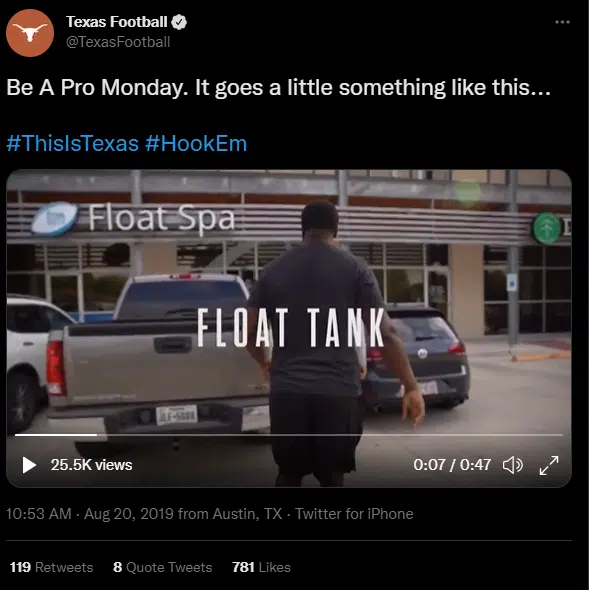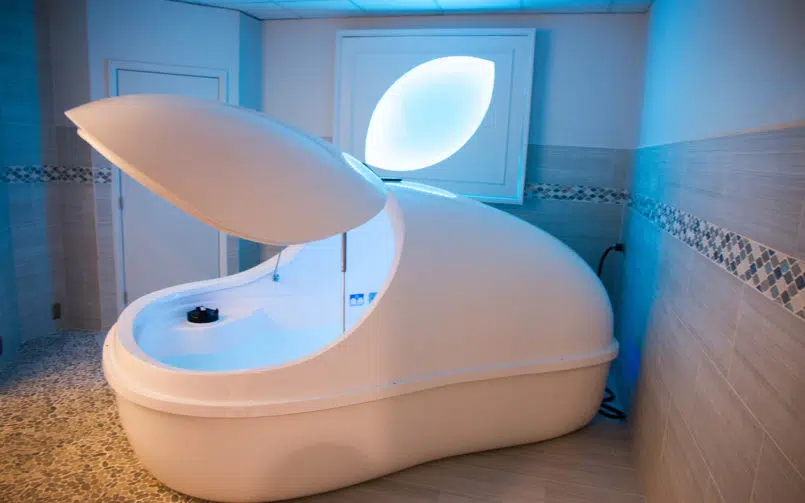It is no secret that professional athletes must commit years of hard work and dedication to succeed. Not only must they train diligently, but they must also ensure their bodies can recover from the demands of strenuous activity. While there is no one-size-fits-all solution for athletic recovery, there are a host of recovery options available to professional athletes. One helpful starting point is to remember that every athlete is different and therefore will require different recovery methods depending on their sport, intensity level, and training schedule.
However, there are some general tips that all athletes can follow to improve their recovery process, including the holistic practice of float therapy.
What Exactly is Athletic Recovery?
Athletic recovery is the process of rebuilding and repairing the tissues in your body that are broken down during exercise. As an important part of any fitness program, this process helps improve athletic performance and minimize the possibility of injury. Common recovery methods include rest, ice therapy, compression, massage, and most recently, floatation therapy.
While each athlete will have their own unique recovery process, there are proven best practices and general guidelines that can help improve recovery time. For example, it is important to stay hydrated, eat a balanced diet, and get enough sleep. By following these simple tips, you can help ensure that the body has the tools it needs to recover from strenuous physical activity.
Why Do Athletes Need Athletic Recovery to Recover Faster?
Athletes need athletic recovery for several reasons. First, it helps them avoid injury. When muscles are worked, they can become fatigued and weak, leading to strains and other injuries. Second, athletic recovery helps athletes perform at their best. Athletic recovery also promotes muscle recovery, allowing an athlete’s muscles to repair and rebuild so they can be stronger and more powerful when they compete. Third, athletic recovery helps athletes to stay fit and healthy. Another benefit of proper recovery is the removal of harmful toxins from the body and improved circulation.
Athletic recovery can also help athletes mentally recover from the stresses of competition, enabling them to relax and refocus so they can perform at their best when it really counts. Additionally, athletic recovery helps prevent burnout. When athletes ignore the time needed to recover, they can become overstrained and possibly lose their passion for their sport. Athletic recovery is essential for all athletes whether they’re professional or recreational. By taking the time to recover, athletes can reduce their risk of injury, improve their performance, and prevent burnout. Athletic recovery is an essential part of any athlete’s training regimen.
Athletic Warm-ups and Cool-downs
It’s common practice for individuals who work out to warm up before exercising. When you warm up, your muscles are essentially telling your body that you are about to begin aerobic activity. When you are stretching, your body temperature increases and blood flow to your muscles increases. Warm-ups are essential to prevent injuries and reduce the risk of enduring damage or soreness to your physical body.
The same is true for post-exercise cool-downs. Post-workout cool-downs essentially bring down your body’s temperature as well as slow down your heart rate and blood pressure. Cool-downs also accelerate your body’s recovery of lactate in the blood. Lactate is a molecule that is produced when you lack sufficient oxygen. It’s formed when pyruvate, the end-product of sugar breakdown, accepts an electron from a part of the cell called NADH.
Cool-downs often include some sort of active recovery and improved muscle recovery. Active recovery is any form of low-intensity exercise that immediately follows a hard workout. Examples of active recovery include yoga and walking.
Is Athletic Recovery the Same as a Warm-up/Cool-down?
No. Athletic recovery and a post-workout cool-down are two different things. Athletic recovery is what you do after your workout to help your body’s muscles recover and rebuild. A post-workout cool-down helps your body cool down after a workout.
The Risks of Skipping Athletic Recovery
The absence of an adequate athletic recovery method may result in short-term issues such as lightheadedness, dizziness, and even lactic acid buildup.
Lactic acid buildup, which is mainly produced in muscle cells and red blood cells, is predominantly a chemical in the body that forms as the body turns glucose into energy. The body breaks down carbohydrates from glucose. As we exercise at high-intensity levels, the lactic acid produced is generally cleared. If we are training or pushing our bodies, however, it may be unable to keep up, which induces the body to increase its production of lactic acid. Muscles then become fatigued, and performance dissipates. Stress or fatigue-related injuries are therefore more likely to happen.
What are Considered Athletic Recovery Strategies?
The primary purpose of athletic recovery is to help the athlete’s body repair and rebuild after strenuous physical activity. This process is essential for maintaining peak performance levels and preventing injuries. Recovery typically includes a combination of rest, nutrition, and targeted exercises.
Rest is important for allowing the body to repair tissue damage and reduce inflammation. Nutrition plays a critical role in providing the nutrients needed for recovery such as protein for muscle growth and glycogen for energy production. And lastly, exercises can help to improve range of motion and increased blood flow. By incorporating all these elements, athletes can maximize their performance and reduce their risk of injury.
Alternative Therapies for Athletic Recovery – Float Tanks
Floatation therapy is a type of sensory deprivation that is growing in popularity, especially among athletes. This therapy involves lying in an egg-shaped float pod that is saturated with Epsom salt, allowing the body to float effortlessly on the surface. The tank is typically kept at skin temperature and is completely dark and quiet, providing a deep sense of peace and relaxation.
While it may sound like something out of a science fiction movie, floatation therapy has a variety of benefits including stress reduction, sleep deprivation, and athletic recovery. The practice reduces the brain’s need to process inputs of the five senses, thereby eliminating distractions, removing gravity, and reducing weight on the body. Some research suggests this therapy can also help to improve overall mood and promote creativity. Whether you’re an athlete looking to speed up your recovery time or simply looking for a new way to relax, floatation therapy might be worth a try.
In addition to floatation therapy, other alternative therapies that athletes use for recovery include massage, hyperbaric oxygen therapy, cupping, and whole-body cryotherapy.
Float Therapy Recovery Techniques for Athletes
Elite athletes have been using floatation therapy for athletic recovery for years to help with both physiological and psychological issues. The zero-gravity environment of the float tank allows their muscles and joints to completely relax, helping them reduce pain and inflammation. Since the tanks are also filled with Epsom salt, athletes can experience the proven benefits of improved circulation and natural healing. In addition, the low levels of light and sound inside the tanks help professional athletes relax and clear their minds, which is essential for optimal performance.
Over the last several years, floating has been used by many elite athletes to treat various sports-related conditions, facilitate aid in recovery, and better manage the physical stresses in their bodies.
- Austin’s professional soccer team, Austin FC, offers True REST Float Spa therapy sessions to its players as a recovery method. The players float at True REST Float Spa North Austin. In addition to its physical benefits, floatation therapy can also help to improve focus and mental clarity, which can be instrumental for athletes who need to maintain peak performance levels.
- A major professional football team local to North Carolina recently purchased True REST Float Spa’s patented round pods so players can float for recovery and pre-game focus and visualization.
- The University of Texas football team is another major organization turning to flotation therapy. Texas Longhorn football players improve recovery time, manage injuries before they happen, reduce muscle tension, and outperform competitors by harnessing the under-utilized power of relaxation and floatation therapy at True REST Float Spa North Austin.

The list of collegiate and professional sports teams and star players who use floatation therapy is growing and includes the following:
- Buffalo Bills, NFL Franchise Buffalo Bills
- Carl Lawson, Cincinnati Bengals – Told ESPN “It makes your body feel loose.” ESPN
- Geno Atkins, NFL – Bengals ESPN
- Golden State Warriors, NBA Franchise – Introduced to floating by Lachlan Penfold, the Golden State Warriors Australian
- James Magnussen, Australian Olympic Bronze Medalist – Swimming – https://www.facebook.com/jamesmissilemagnussen/photos/a.257081834323079/1525633894134527/?type=3
- KeiVarae Russell, Cincinnati Bengals – Twitter
- Michael Roberts, NFL – Green Bay Packers – ESPN
- Notre Dame, College Football – Indy Star
- Ohio State football players – Sports Illustrated
- Philadelphia Eagles, NFL Franchise – Orlando Sentinel
- Phillips Idowu, British Olympic Silver Medalist – Triple Jumper – Used floatation therapy to help with a back injury
- Steph Curry, NBA – Golden State Warriors https://youtu.be/Z8IYV25T_WQ “It’s an opportunity to just relax,” Curry told ESPN. “Get away from all the stresses on the court and in life, but it also has some physical benefits as well, with the salt.”
- Stephen Curry – https://youtu.be/vfhZA8uAYlg
- The Dallas Cowboys, NFL Franchise — In the 1980s, the team reportedly used float tanks to expedite the healing processes for injured players Orlando Sentinel
- Tom Brady – NFL – Forbes
Try Zero-Gravity as a Recovery Method
The best aspect of flotation therapy is its zero-gravity environment. Tension is immediately relieved, and inflammation of the muscles and joints reduces because the water-Epsom salt mixture is responsible for suspending the body as if you were resting on a comfortable cloud.
Floating in a float pod lowers one’s heartrate, decreases blood pressure, reduces lactic acid buildup, and resets the body for a deep feeling of rest and relaxation. Because individuals can benefit from a complete state of calm, the zero-gravity environment of float therapy is also known to help with sleeping or insomnia, reducing pain points and allowing the body to decompress.
Ultimately, the body can rest, which is one of the most significant factors any athlete can ask for to counter the physical extremities their professional career might present.
Can Others Use Float Therapy as an Athletic Recovery Tool?
Fortunately, float therapy can be used by anyone, not just professional athletes. Maybe you’re someone who has a prominent workout routine or an individual who wants to find a moment to focus on complete self-care. Floating is perfect for anyone who wants to discover complete and total body wellness.
And that’s where True REST Float Spa comes in: As the world’s largest float therapy brand, the holistic wellness spa is ready to provide everyone with a rejuvenating self-care experience. There are spa locations across the country, but finding one nearest you is easy by visiting truerest.com/locations. You can also learn more about float therapy and its benefits at truerest.com/float-therapy.


